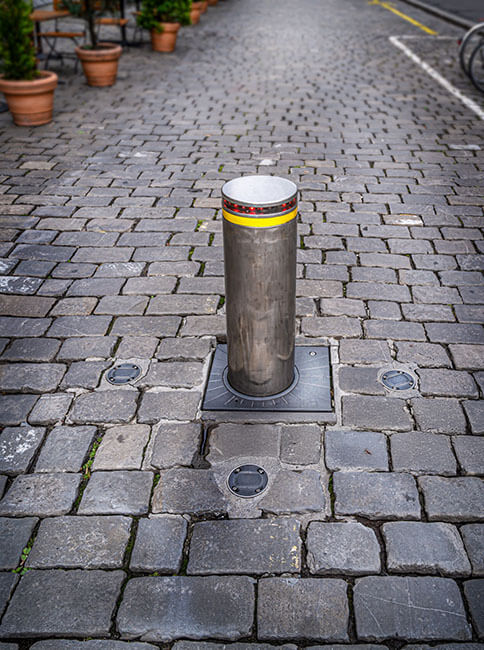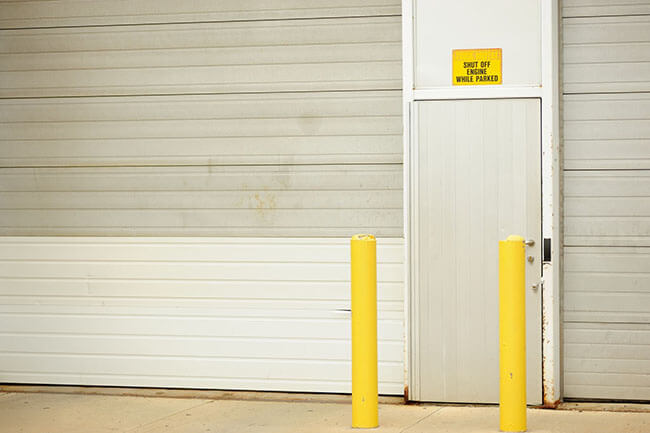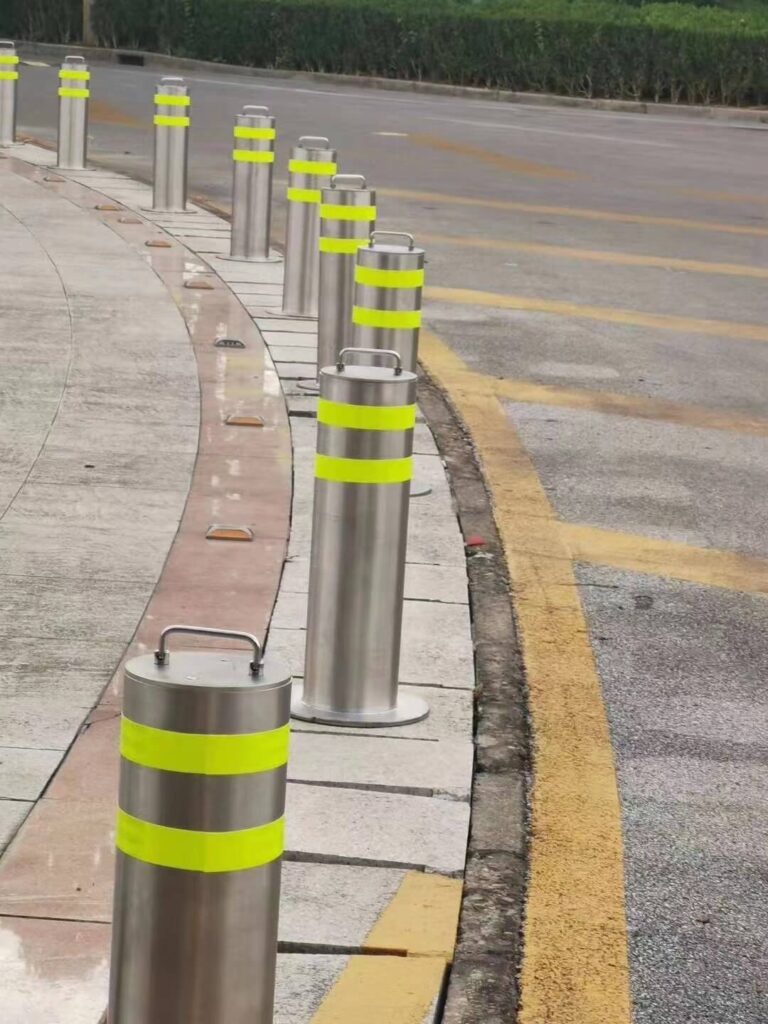Einführung
In the sphere of modern facility and perimeter security design, the bollard is often an overlooked, yet critically important, element. Far from being simple posts, bollards are sophisticated components of a comprehensive security and traffic management strategy. They serve a dual purpose: to protect assets, infrastructure, and personnel from vehicular threats, and to define, guide, and enhance the aesthetic appeal of public and private spaces.
The decision of which bollard to deploy is complex, moving beyond mere material and color selection. It requires a deep understanding of site-specific risks, operational requirements, and regulatory compliance. A poorly chosen Poller can represent a significant security vulnerability, while an optimally selected and installed system can provide robust, multi-layered protection and seamless integration with the surrounding environment.
This comprehensive guide is designed for facility planners, security directors, and project managers who are tasked with specifying and implementing bollard solutions. It moves past superficial descriptions to provide a detailed, professional analysis of the primary bollard categories, their functional mechanisms, the critical factors influencing selection, and the advanced standards that govern high-security applications. Our goal is to equip you with the technical knowledge necessary to make an informed decision that balances security efficacy, operational flexibility, and long-term cost-effectiveness.

Categorizing Bollards by Function and Operation
Bollards can be broadly classified into three main categories based on their primary function: Protective/Security, Traffic Management/Access Control, and Aesthetic/Delineation. Understanding these functional distinctions is the first step in the selection process.
1. Protective and Security Bollards
The primary role of this category is to prevent unauthorized vehicle intrusion, whether accidental or malicious. The distinction between general protection and high-security protection is crucial.
A. Fixed Bollards (Permanent)
Fixed bollards, often constructed from steel pipe and filled with concrete, are the bedrock of permanent perimeter defense. They are secured into a deep foundation, making them immovable.
• Core-In Installation: The most common method involves coring into the substrate and setting the bollard deep within the foundation, providing maximum rigidity and strength.
• Surface-Mounted (Plated) Installation: Used where deep excavation is impossible (e.g., parking garages, utility-heavy areas). While offering less impact resistance than core-in, they provide a strong visual and physical deterrent for low-speed impacts.
Key Applications: Protecting storefronts, utility boxes, gas pumps, building corners, and critical infrastructure where permanent, unyielding protection is mandatory.
B. Crash-Rated Bollards (HVM – Hostile Vehicle Mitigation)
These are the most robust form of security bollards, specifically engineered and tested to stop vehicles of a defined weight traveling at a specific speed. Compliance is measured against rigorous international standards.
• M-Ratings (ASTM F2656): The American standard, where M30, M40, and M50 refer to the ability to stop a 15,000 lb (6,800 kg) vehicle traveling at 30, 40, or 50 mph (48, 64, or 80 km/h), respectively. The rating also includes penetration distance.
•K-Ratings (DOS SD-STD-02.01): An older, but still referenced, standard. A K12 rating, for example, is equivalent to stopping a 15,000 lb vehicle at 50 mph.
• IWA 14-1 & PAS 68: European and international standards that define the performance of vehicle security barriers, offering precise metrics on impact speed, vehicle mass, and dynamic penetration.
Key Applications: Government facilities, embassies, airports, data centers, stadiums, and any area deemed a high-value target requiring maximum protection against vehicular attack.
2. Traffic Management and Access Control Bollards
These bollards are designed to manage the flow of vehicles and pedestrians, offering flexibility to grant or deny access as operational needs change.
A. Retractable (Automatic/Telescopic) Bollards
Retractable bollards are the pinnacle of dynamic access control. They can be lowered flush into an in-ground cassette to allow vehicle passage and raised to block access.
• Automatic Operation: Controlled by remote, key card, loop detector, or security system integration. Typically powered by hydraulic or electromechanical systems, offering rapid deployment and high cycle rates.
• Semi-Automatic Operation: Utilizes a gas spring or hydraulic assist mechanism, allowing manual lowering and automatic rising upon key release. Ideal for areas with moderate usage where a power supply may be impractical.
• Manual Operation: Requires an operator to manually raise and lower the bollard. Best suited for low-frequency access points.
Key Applications: Controlled entry points, emergency vehicle access lanes, temporary pedestrian zones, and facilities that require variable security perimeters throughout the day.
B. Removable Bollards
Removable bollards provide a simple, cost-effective solution for temporary access control. They lock into a permanent ground sleeve and can be manually lifted out and stored when access is required.
•Mechanism: Typically secured with a padlock or internal locking mechanism.
• Advantages: Low cost, easy installation (compared to retractable), and full removal of the obstruction.
•Disadvantages: Requires manual labor for removal and storage space.
Key Applications: Maintenance access points, loading docks during non-operational hours, and temporary closure of walkways or parking areas.
C. Collapsible/Fold-Down Bollards
These bollards pivot on a hinge at the base, folding down flat onto the ground. They are primarily used for reserving parking spaces or granting access to authorized personnel (e.g., delivery drivers).
•Mechanism: Locked in the upright position, unlocked with a key to fold down.
•Note: They offer minimal crash resistance and are primarily a deterrent for unauthorized parking or access.
Key Applications: Individual parking space reservation, temporary access to alleys or service entrances.

3. Aesthetic and Delineation Bollards
These bollards primarily serve to define boundaries, guide traffic, and enhance the visual appeal of a site. While they may offer some level of physical separation, their main function is visual.
A. Decorative Bollards
Often made from cast iron, aluminum, or stainless steel, these bollards are designed to complement the architectural style of a building or landscape. They frequently incorporate intricate designs, finials, and specific finishes.
• Function: Architectural enhancement, boundary demarcation, and low-level physical separation.
• Note: They are frequently used as covers over structural steel pipe bollards to combine aesthetics with protection.
B. Flexible/Delineator Bollards
Constructed from durable, flexible polymers (such as polyurethane), these bollards are designed to bend upon impact and return to their original, upright position.
• Function: Traffic guidance and delineation of lanes or parking spots. They minimize damage to vehicles and the bollard itself upon accidental contact.
•Note: They offer no security protection against vehicular intrusion.
C. Lighted Bollards
These can be any of the bollard types (fixed, decorative, or flexible) that incorporate internal or external lighting elements.
• Function: Illumination of pathways, increased visibility (both for safety and as a deterrent), and enhanced nighttime aesthetics.
•Power: Often low-voltage LED, powered by the main electrical supply or integrated solar panels.
The Six Critical Factors for Bollard Selection
Choosing the optimal bollard requires a systematic evaluation of the site’s needs against the bollard’s capabilities. The following six factors are paramount in this decision-making process.
1. Threat and Risk Assessment (The “Why”)
The most fundamental question is: What is the bollard intended to stop?
•Accidental Impact: Protection against low-speed, unintentional vehicle contact (e.g., parking mishaps, delivery truck maneuvering). This requires a standard fixed or surface-mounted bollard.
•Deliberate Attack (Ram-Raid): Protection against a vehicle used as a weapon to breach a perimeter or gain access to a building. This necessitates a crash-rated (HVM) bollard with an M or K rating appropriate for the assessed threat speed and vehicle mass.
• Delineation/Guidance: The need to visually guide traffic or pedestrians. This can be met with flexible or decorative bollards.
A professional threat assessment will define the necessary crash rating (M30, M50, etc.) and the required spacing between bollards to ensure a continuous line of defense.

2. Operational Access Requirements (The “How”)
The frequency and nature of authorized vehicle access dictate the bollard’s mechanism.
| Access Requirement | Recommended Bollard Type | Operational Considerations |
| No Access Ever | Fixed Bollard (Core-In) | Maximum security; zero flexibility. |
| Infrequent, Planned Access | Abnehmbarer Poller | Requires manual labor for removal and storage. |
| Frequent, Controlled Access | Automatic Retractable Bollard | Highest upfront cost; requires power and maintenance; offers speed and convenience. |
| Occasional, Emergency Access | Semi-Automatic or Collapsible Bollard | Good balance of security and ease of use; no external power required for semi-automatic. |
| Temporary, Event-Based Access | Portable Bollard (Crash-Rated or Standard) | Ideal for rapidly deploying a temporary perimeter. |
3. Installation Environment (The “Where”)
The physical characteristics of the site heavily influence the installation method.
• Subsurface Constraints (Utilities): Urban areas or sites with extensive underground utilities (gas, water, electrical conduits) often prevent deep excavation. In these cases, Shallow Mount Bollards are essential. These are crash-rated bollards engineered to achieve high-security standards with a foundation depth of 14 inches (350mm) or less.
• Surface Material: The type of pavement (concrete, asphalt, pavers) affects the stability and anchoring method. Surface-mounted bollards are often used on existing concrete slabs.
•Water Table/Drainage: Installation must account for proper drainage to prevent water accumulation in the bollard’s foundation or, in the case of retractable systems, in the ground cassette.
4. Material and Durability
The material choice impacts longevity, maintenance, and impact resistance.
• Steel: The standard for high-security and protective bollards due to its superior strength and impact absorption. Requires finishing (e.g., powder coating, bollard covers) to prevent corrosion.
• Stainless Steel: Highly durable, corrosion-resistant, and aesthetically modern. Often used for decorative or high-visibility applications where a sleek finish is desired.
•Concrete: Used for fixed, heavy-duty applications. Can be architecturally integrated but is prone to spalling or cracking upon significant impact.
• Polymer/Plastic: Used exclusively for flexible, delineator, or decorative cover applications. Offers no security protection.
5. Aesthetics and Integration
Bollards must integrate seamlessly with the site’s architectural design.
• Architectural Harmony: Decorative bollard covers can be placed over protective steel posts to maintain a consistent visual theme. Finishes such as powder coating, custom colors, or specialized caps should be considered.
• Visibility: Bollards intended for safety must be highly visible. This is achieved through color contrast (e.g., safety yellow), reflective tape, or integrated lighting.
•Lighting: Lighted bollards not only enhance aesthetics but also improve pedestrian safety and act as a visual deterrent against crime in poorly lit areas.

6. Regulatory and Compliance Standards
For any project involving public safety or high-security, adherence to standards is non-negotiable.
• ADA Compliance: Bollard placement must ensure a clear path for pedestrians and not create tripping hazards. Retractable bollards, when lowered, must be flush with the ground.
• Local Ordinances: Municipalities may have specific requirements regarding bollard height, color, setback from the curb, and the need for permits, especially in public rights-of-way.
• Crash Testing: As detailed in Part I, ensuring the bollard has been independently tested and certified to a recognized standard (ASTM, IWA, PAS) is crucial for HVM applications.
Advanced Considerations in Bollard Technology and Installation
Moving beyond the basic types, modern bollard systems offer sophisticated features that can significantly enhance security and operational efficiency.
1. The Necessity of Shallow Mount Technology
The rise of urban development and the complexity of subsurface infrastructure have made traditional deep-foundation bollard installation increasingly difficult and costly. Shallow mount technology represents a significant engineering advancement.
Traditional Poller may require a foundation up to 4 feet (1.2 meters) deep. Shallow mount bollards achieve the same M-rated security performance with a foundation depth often less than 1 foot (300mm). This is accomplished through advanced engineering that utilizes the surrounding pavement and a wider, reinforced foundation plate to distribute the impact load horizontally rather than relying solely on vertical depth.
Benefits of Shallow Mount: * Reduced Installation Time and Cost: Less excavation means lower labor and material costs. * Utility Avoidance: Minimizes the risk of damaging existing underground utilities, which is a major project constraint in dense areas. * Vielseitigkeit: Allows for the installation of high-security barriers in locations previously considered impossible, such as over bridges or complex utility corridors.
2. Integration with Access Control Systems
Automatic retractable bollards must be viewed as an integral part of a larger access control ecosystem.
• Vehicle Detection: Systems often use induction loops buried in the pavement to detect the presence of authorized vehicles (e.g., staff cars with transponders) or to prevent the bollard from raising while a vehicle is positioned over the cassette.
•Security Integration: The bollard system should interface with the facility’s main security management system (SMS). This allows for remote operation, logging of all cycles, and automated response to security alerts (e.g., automatic raising during a lockdown scenario).
• Intercom and Camera Systems: For visitor access, a fully integrated system includes an intercom and a camera to allow security personnel to visually verify and grant access remotely.
3. Bollard Covers: Combining Protection and Aesthetics
While a steel pipe bollard provides the necessary structural integrity, its appearance is often industrial and prone to rust. Bollard covers solve this by offering a protective, aesthetic, and low-maintenance layer.
• Aesthetic Enhancement: Covers are available in a vast array of colors, materials (polyethylene, decorative metal), and shapes (round, square, custom architectural designs). They allow the bollard to blend into or enhance the site’s design.
•Maintenance Reduction: A high-quality plastic or polymer cover eliminates the need for repeated scraping, priming, and painting of the steel post, significantly reducing long-term maintenance costs and protecting the underlying steel from the elements.
•Increased Visibility: Covers can be manufactured in high-visibility colors or with integrated reflective tape, ensuring the bollard is easily seen by drivers and pedestrians.
4. The Importance of Proper Spacing and Setback
The effectiveness of a bollard line is not just about the strength of the individual posts, but how they are arrayed.
• Spacing: To prevent a vehicle from passing between two bollards, the clear space between the posts must be less than the width of the smallest vehicle (typically a standard car). A common recommendation is a maximum clear space of 3 to 5 feet (0.9 to 1.5 meters), but this must be confirmed by the crash-test certification for HVM applications.
• Setback: This is the distance between the bollard line and the asset it is protecting (e.g., a building facade). The setback must be greater than the maximum penetration distance specified in the bollard’s crash rating. For example, an M50 bollard with a P1 rating means the vehicle penetrated less than 1 meter past the bollard line. The asset must be set back far enough to accommodate this penetration distance.

Long-Term Management and Maintenance
The lifecycle cost of a bollard system extends far beyond the initial purchase and installation. Proper maintenance is essential to ensure continued security efficacy and operational reliability.
1. Maintenance for Fixed Bollards
Fixed bollards require minimal maintenance, primarily focused on maintaining the integrity of the surface finish and the surrounding pavement.
• Corrosion Control: For steel bollards without covers, regular inspection for rust and re-coating is necessary. Bollard covers eliminate this recurring task.
• Foundation Integrity: Inspect the surrounding concrete or asphalt for cracks or heaving, which can compromise the bollard’s foundation and reduce its impact resistance.
2. Maintenance for Automatic Retractable Systems
Retractable systems are mechanical and require a proactive maintenance schedule to ensure smooth, reliable operation.
• Hydraulic/Electromechanical System Check: Regular inspection of fluid levels (for hydraulic systems), seals, motors, and wiring is critical. Failure to maintain these components can lead to system failure, leaving the bollard either permanently raised or lowered.
• Ground Cassette Cleaning: The in-ground housing (cassette) must be kept free of debris, dirt, and standing water. Poor drainage or debris can impede the bollard’s movement and lead to corrosion.
• Cycle Testing: Periodic testing of the raising and lowering mechanism should be conducted to ensure the response time meets the required operational standard.
3. Post-Impact Evaluation
Any bollard that has been struck by a vehicle, regardless of the apparent damage, must be professionally evaluated.
• Structural Integrity: Even if a fixed bollard appears undamaged on the surface, the force of an impact can compromise the integrity of its deep foundation. A compromised foundation means the bollard will not perform to its rated standard in a subsequent impact.
• HVM Recertification: A crash-rated bollard that has successfully stopped a hostile vehicle attack may need to be fully replaced to restore the security perimeter to its certified standard. The bollard has fulfilled its purpose, but its structural integrity is now compromised.
Schlussfolgerung
The selection of a Poller is a strategic decision that directly impacts the safety, security, and functionality of a facility. By moving beyond a simple visual preference and adopting a systematic approach based on the six critical factors—Threat Assessment, Operational Access, Installation Environment, Material, Aesthetics, and Compliance—facility planners can ensure they specify a solution that is technically sound and perfectly aligned with their site’s long-term needs.The modern bollard market offers solutions for every scenario, from the subtle delineation of a pedestrian walkway to the robust, certified protection of a high-security perimeter. By prioritizing the function over the form, and by understanding the engineering nuances of fixed, removable, and dynamic systems, you can transform a simple post into a powerful, professional component of a resilient security strategy. The right bollard is not just a barrier; it is a commitment to uncompromising safety.




